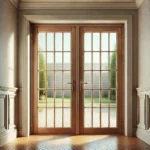Doors are an essential element of any building, serving both functional and aesthetic purposes. One common question often asked during construction or renovation projects is, “How tall are doors?” While the height of doors can vary depending on the type of building, cultural norms, and specific design preferences, there are standard measurements that are commonly used in residential and commercial spaces. Understanding these dimensions is crucial for ensuring functionality, compliance with regulations, and harmonious design.
In residential construction, the standard height for most doors is approximately 80 inches, or 6 feet 8 inches (about 203 centimeters). This dimension is widely used for interior doors, such as bedroom, bathroom, and closet doors. It provides enough clearance for the average person to pass through comfortably while maintaining proportions that work well in most home designs. This height has become a default choice in many regions due to its practicality and ability to fit within typical ceiling heights.
For exterior doors, the standard height is usually the same—80 inches. However, in some cases, taller doors measuring 84 inches (7 feet) or even 96 inches (8 feet) are used to create a grander entrance or to accommodate higher ceilings. These taller doors are often seen in luxury homes or buildings with modern architectural designs, where creating a sense of scale and openness is a priority. The additional height can make a significant impact on the overall aesthetics, giving the entrance a more imposing and elegant appearance.
Commercial buildings often have different standards for door heights due to varying requirements and regulations. In office buildings, retail stores, and public spaces, the height of doors typically aligns with the standard 80 inches for interior doors. However, entryways and main doors in commercial settings are frequently taller to accommodate higher traffic and comply with accessibility standards. Doors that are 84 inches or even 96 inches tall are common in these settings, providing ease of movement for both people and goods.
In addition to standard door heights, customized dimensions are often used to meet specific needs or design preferences. For example, in homes with vaulted or cathedral ceilings, taller doors may be chosen to maintain balance and proportion. Similarly, in historic or period-style homes, door heights may vary to reflect the architectural norms of the time. In such cases, doors might be shorter or taller than the modern standard, depending on the era and style being emulated.
The height of a door also plays a role in its functionality. For example, taller doors are often used in spaces that require additional clearance, such as garages, warehouses, or industrial buildings. Garage doors, in particular, are designed to accommodate vehicles and typically range in height from 7 feet to 8 feet, with custom sizes available for larger vehicles like trucks or RVs. In industrial settings, rolling or sectional doors can reach heights of 12 feet or more to allow for forklifts, machinery, or large shipments.
In regions with specific building codes or cultural preferences, door heights may differ from the standard measurements commonly used in other areas. For instance, in some countries, residential doors may be slightly shorter or taller than the 80-inch standard due to traditional construction practices or the average height of the population. Additionally, certain building codes may mandate minimum or maximum door heights to ensure accessibility and safety.
Accessibility is an important consideration when determining door height, especially in public or commercial spaces. The Americans with Disabilities Act (ADA) and similar regulations in other countries require doors to meet specific height and width criteria to ensure they are usable by individuals with mobility aids, such as wheelchairs or walkers. While the standard height of 80 inches typically satisfies these requirements, larger doorways may be necessary in some cases to provide adequate clearance.
When planning or designing a space, it’s important to consider how door height will interact with other architectural elements. For example, the height of doorways should complement the ceiling height to create a sense of balance and proportion. In spaces with lower ceilings, standard-height doors are often the best choice to maintain harmony, while taller doors can be used in rooms with higher ceilings to enhance the sense of scale.
The height of a door can also influence its visual impact within a space. Taller doors are often associated with grandeur and sophistication, making them a popular choice for entryways, dining rooms, or formal living areas. Shorter doors, while less common in modern construction, can evoke a sense of coziness and intimacy, which might be desirable in certain settings, such as cottages or historic homes.
Modern trends in architecture and interior design have seen a growing preference for taller doors, particularly in luxury homes and contemporary spaces. Doors that extend to 96 inches or even higher create a dramatic effect, emphasizing verticality and openness. These doors are often paired with sleek, minimalist designs and large glass panels to enhance the feeling of light and space.
Despite the variety of door heights available, installation often requires careful planning to ensure the doors fit properly within the structural framework of the building. Standard door heights are designed to work seamlessly with standard door frames and hardware, simplifying the installation process. For custom door heights, additional adjustments to the frame, hinges, or supporting structures may be necessary to achieve a perfect fit.
In addition to height, the width and thickness of a door are also important considerations. These dimensions are typically determined based on the door’s intended use, the size of the opening, and the architectural style of the building. While the height of a door is often the most noticeable feature, its overall proportions play a significant role in its functionality and aesthetic appeal.
In conclusion, the height of a door is a critical factor in both its functionality and design. Standard heights of 80 inches are widely used for residential and commercial doors, offering a practical and versatile solution for most applications. Taller doors, ranging from 84 to 96 inches or more, are often chosen for their aesthetic impact and ability to complement larger spaces or higher ceilings. Whether adhering to standard measurements or opting for custom dimensions, the height of a door should be carefully considered to ensure it meets the needs of the space and enhances the overall design. By understanding the factors that influence door height, homeowners and designers can make informed decisions that balance practicality, style, and functionality.
![]()





